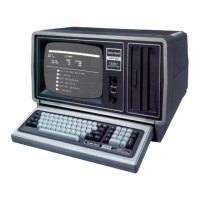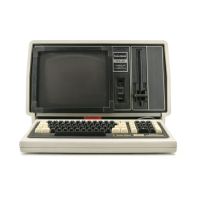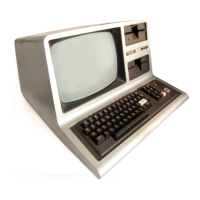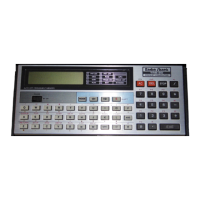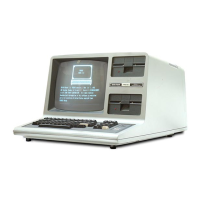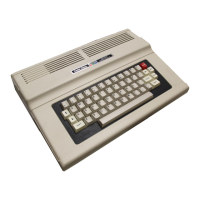19
3C00 - 3FFF
Video RAM
4000 - 7FFF
RAM (16K) End of one 32K Bank
8000 - FFFF
RAM (32K) Second 32K Bank
Memory Map III
0000 - 7FFF
RAM (32K) End of One 32K Bank
8000 - F3FF
RAM (29K) Second 32K Bank
F400 - F7FF
Keyboard
F800 - FEFF
Video RAM
Memory Map IV
0000 - 7FFF
RAM (32K) One 32K Bank
8000 - FFFF
RAM (32K) Second 32K Bank
(See Figure 3-2 for 128K Maps)
3.1.5 ROM
The Model 4 Microcomputer contains 14K of Read
Only Memory (ROM), which is divided into an 8K
ROM (U68), a 4K ROM (U69), and a 2K ROM (U70).
ROMs used have three-state outputs which are
disabled if the ROMs are deselected. As a result,
ROM data outputs are connected directly to the CPU
data bus and do not use data buffer U71, which is
disabled during a ROM access.
ROMs are Model III compatible and contain a BASIC
operating system, as well as a floppy disk boot
routine. The enable inputs to the ROMs are provided
by the address decoding section, and are present
only in the Model III mode of Operation.
3.1.6 RAM
Three configurations of Random Access Memory are
available on the Model 4:16K, 64K, and 128K. The
16K option uses 4116 type, 16K by 1 dynamic RAMs,
which require three supply voltages (+12 volts, +5
volts, and -5 volts). The 64K and 128K options use
6665 type, 64K by 1 dynamic RAMs, which require
only a single supply voltage (+5 volts). The proper
voltage for each option is provided by jumpers.
Dynamic RAMs require multiplexed incoming address
lines. This is accomplished by ICs U63 and U76.
Output data from RAMs is buffered by U64. With the
128K option, there are two rows of the 64K by 1 RAM
ICs. The proper row is selected by the CAS signal
from PAL U72.
3.1.7 Keyboard
The Model 4 Keyboard is a 70-key sculptured
keyboard, scanned by the microprocessor. Each key
is identified by its column and row position. Columns
are defined by address lines AO - A7, which are
buffered by open-collector drivers U29 and U30. Data
lines DO - D7 define the rows and are buffered by
CMOS buffers U44 and U45. Row inputs to the
buffers are pulled up by resistor pack RP 1, unless a
key in the current column being scanned is
depressed. Then, the row for that key goes low.
3.1.8 Video
The heart of the video display circuitry in the Model 4
is the 68045 Cathode Ray Tube Controller. The
CRTC allows two screen formats: 64 by 16 and 80 by
24. Since the 80 by 24 screen requires 1,920 screen
memory locations, a 2K by 8 static RAM is used for
the Video RAM. The 64 by 16 mode has a two-page
screen display and a bit in the options register for
determining which page is active for the CPU. Offset
the start address of the CRTC to gain access to the
second page in the 64 by 16 mode.
Addresses to the video RAM are provided by the
68045 when refreshing the screen and by the CPU
when updating the data. These two sets of addresses
are multiplexed by U33, U34, and U35. Data between
the CPU and Video RAM is latched by U6 for a write,
and buffered by U7 for a read operation.
During screen refresh, the data outputs of the Video
RAM (ASCII character codes) are latched by U8 and
become the addresses for the character generator
ROM (U23). In cases of low resolution graphics, a
dual 1 of 4 data selector (U9) is the cell generator,
with additional buffering from U10
The shift register U1 inputs are the latched data
outputs of the character or cell generator. The shift
clock input comes from the PAL U4, and is 10.1376
MHz for the 64 by 16 mode and 12.672 MHz for 80
by 24 operation. The serial output from the shift
register later becomes actual video dot information.
Special timing in the video circuit is handled by hex
latch U2. This includes blanking (originating from
CRTC) and shift register loading (originating from
U4). Additional video control and timing functions,
such as sync buffering, inversion selection, dot clock
chopping, and graphics disable of normal video, are
handled by miscellaneous gates in U12, U13, U14,
U22, U24, and U26.
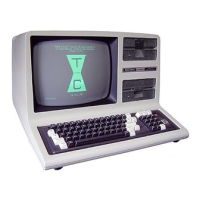
